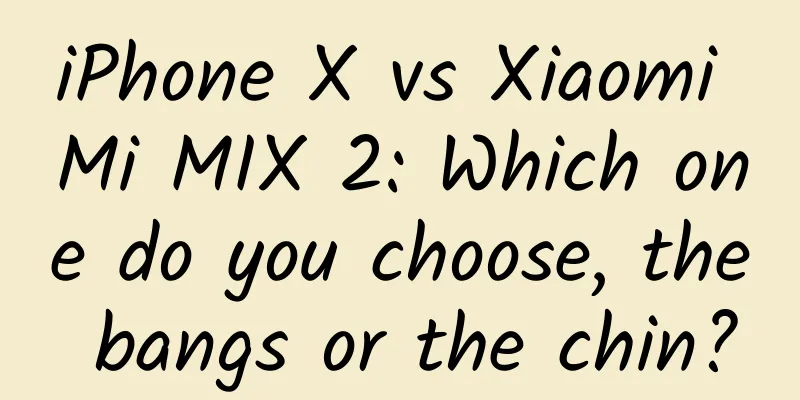iPhone X vs Xiaomi Mi MIX 2: Which one do you choose, the bangs or the chin?

|
Xiaomi Mi MIX 2 and iPhone X have once again proved that full-screen phones are all the rage and mobile phones have entered the "face-oriented era". Manufacturers don't have the time to wait for users to discover true love, and what they want is the fastest way to realize the value. The full screen is an alienation of the phone's appearance rather than an evolution. Theoretically, a mobile phone can be called a full-screen only if the front is entirely screen, but the actual standard is that a mobile phone with a screen-to-body ratio of more than 80% is called a full-screen. The instigator was the AQUOS Crystal released by Sharp in 2014. It had a 5-inch 720P screen and a screen-to-body ratio of 83%. It boldly used bone conduction to reduce holes. However, the mobile phone competition at that time was still in the era of large screens and narrow bezels, and there was no concept of full screens. Sharp's efforts in AQUOS Crystal were just a show of skill by a panel manufacturer, not real innovation. It was only since last year, when the iPhone had used up all the benefits of large screens, that manufacturers began to notice the potential of full-screen phones. This was the case with the iPhone X, Xiaomi MIX 2, Samsung Galaxy S8 series, Sharp's new AQUOS S2, and the upcoming Huawei Mate 10, vivo's X20, OPPO, Gionee and other brands' new phones. The Xiaomi Mi MIX 2 and iPhone X, which were first unveiled, demonstrated the latest progress in full-screen displays. First of all, neither of them is a true full screen, the former retains a smaller chin, and the latter has a bangs whose appearance is controversial. Lei Jun is proud of retaining the right to invent the full screen, but a more accurate definition is that Xiaomi did invent the term full screen, not the full screen mobile phone itself. Secondly, the full screen has not changed the entire competitive landscape. Although the configuration of Xiaomi MIX 2 can be regarded as the best Android phone, the price of 3,299 yuan shows that Lei Jun still adheres to the concept of "cost-effectiveness" and dares not be overconfident. The iPhone X, unveiled at the newly built Steve Jobs Theater, is the 10th anniversary model and of course represents the highest level of Apple mobile phones. This is reflected in the application of a large number of new technologies, Face ID, the new UI of iOS11, plus the most powerful A11 processor in history, and the rear vertical dual-camera lens also takes into account AR expansion. What is most commendable is that Apple still maintains the legacy of Steve Jobs and pursues a balance between experience and technology. For example, although there are technical difficulties in the under-screen fingerprint recognition of the full screen, the iPhone X does not follow the RGB single-camera 2D face recognition technology of the Samsung S8, nor does it use the rear fingerprint like the Xiaomi MIX2. Instead, it uses the most difficult structured light dual-camera 3D face unlocking (unless the face is 3D printed, it is difficult to unlock). Of course, Lei Jun is not unaware of this. Xiaomi Note 3 uses face recognition unlocking in cooperation with Megvii Technology, and the recognition speed has reached 500ms. The reason why he insists on under-screen fingerprint may be to create a gimmick for full-screen 3.0. However, the full-screen war has obvious compromises for Android phones. The full screen 2.0 that Lei Jun is calling for is just a compromise solution that sacrifices user experience when a series of technologies are not yet mature. The so-called full screen cannot be regarded as a new direction of mobile phone technology. At most, it is a means of differentiated competition brought about by hardware progress, just like the Internet celebrity faces that have been flooded with live broadcasts and short videos. Although they have been complained about as narrow aesthetics, they do represent the ability to quickly realize cash. The rapid replacement of curved and flexible screens by full-screen displays has indeed brought about several important changes to the mobile phone industry. 1. Replace practicality with aesthetics This trend has existed for a long time. When full-screen phones reached their peak, all the advantages of the latter were concentrated on the perceptible level. First, there was a strong visual impact. A 6.2-inch full-screen phone is equivalent to the size of a 5.5-inch phone, with a higher pixel density of 564PPI. Its appearance was also greatly improved when the screen was off. Second, it improved the experience of playing games, watching videos, and reading pictures and texts, and even supported split-screen display of two apps, although there was not much need to do so. 2. Excessive innovation without sufficient technical reserves will lead to many sequelae and side effects Although full-screen phones have entered the era of mass production, the antennas, camera modules, processes, sensors and even UI still need to be improved. In particular, the UIs of many APPs do not have time to be adapted, which is particularly prominent on Android phones. Lei Jun persuaded Google to accept the display ratio of 17:9 or even 18:9, but this only solved the access problem. Since Android upgrades are very irregular, a large number of applications simply did not have time to adapt to this special screen size. In addition, the era of two-handed control that Steve Jobs resisted during his lifetime will arrive earlier with the full-screen display. Steve Jobs, who has always attached great importance to product experience, once believed that "no one will buy large-screen mobile phones." The main reason he insisted on 3.5 inches was that it was suitable for one-handed control. This is the perspective of a product manager rather than an entrepreneur. Although the 2:1 aspect ratio of full-screen mobile phones makes them feel better to hold, the advantages of this type of mobile phone are all in the scenario of holding it with both hands in horizontal position, which is not what Jobs believes to be the best experience. Of course, his opinion is also somewhat selfish, because Apple had already launched the iPad series of products at that time, and Jobs strongly denied large-screen mobile phones, of course, he did not want to blur the boundaries between the two and evolve into self-competition. 3. Promote hardware competition centered on screens Whether it is a curved screen, a flexible screen or a full screen, it is essentially a hardware battle, which brings two impacts. First of all, the technical requirements are more stringent. Full screen requires fine grinding and cutting, and because of the need to make C-angle or R-angle special-shaped cuts around the screen, it is necessary to use buffer foam to strengthen the structure. The iPhone X makes a U-shaped cut above the screen to leave space for components such as the front camera and distance sensor. These complex processes, combined with body materials with high defect rates such as ceramics, and the fact that the supply chain will not release sufficient production capacity until Q4, will lead to limited supply and rising costs. The second is serious waste. The specification of full screen seems to be a more regular 2:1, but from the perspective of the glass substrate manufacturing process, this will cause more serious waste than 16:9. According to the news from panel manufacturers, the current 5-6 inch 18:9 full screen products will lose about 5-10% in layout economy compared with the traditional 16:9 products. In short, full-screen displays are an unfamiliar competition for most companies in the supply chain, but mobile phone manufacturers such as Samsung and Sharp that have screen technology may profit from it. 4. Experience improvement is disproportionate to cost The most important user bonus of full-screen is the larger display area with the same body size. The 6.2-inch Samsung S8+ and the 5.5-inch iPhone 7 Plus are almost the same size, but the cost of 18:9 HD full-screen has increased by about 8% compared with 16:9 since the beginning of this year, and the cost of FHD has increased by 20%. Innovations such as full-screen phones are the culprit for pushing up mobile phone prices. This is the kind of competition that mobile phone brands and capable supply chain manufacturers like, but if you were a consumer, what would you choose? As for the far-reaching impact of full-screen technology, there are three points we can see at present. For the industry, every innovation is a pitfall for the supply chain Full screen is the culmination of all. For example, due to the narrowing of the frame, the extremely compressed bangs and chin, the main clearance of the entire mobile phone has been reduced from the original 9mm to less than 5mm. Such a small space will affect the RF OTA index of the antenna and reduce the call quality. Therefore, the supply chain has to cut the metal thinner to leave space for the antenna, while also considering how to ensure the structural strength. At the same time, due to the popularization of wireless charging, the integration of antennas and wireless charging rings is also inevitable. In terms of fingerprint recognition, side recognition and the power button fingerprint recognition that Apple previously applied for a patent for are both alternatives, but there are still many difficulties in implementing them on OLED full-screen displays, and other hardware problems are also emerging. For users, the arrival of the 18:9 era will subvert the gaming and video industries This specification optimizes the experience of watching videos, with a stronger sense of shock and immersion. When playing games, the visible area exceeds that of 16:9 mobile phones by about 13%, and the experience of reading pictures, texts and comics is also improved exponentially. From this perspective, it is crucial for manufacturers to promote cooperation between full-screen mobile phones and games, and combine this with adjustments and improvements to the UI system to solve the annoying problem of accidental touches. There will be considerable opportunities behind this. For other industries, full screen means business opportunities for the insurance industry Statistics show that 75% of mobile phone repairs are screen-related, and the cost is staggeringly high. The official website price of replacing the screen assembly of Samsung S8+ is 2,099 yuan, and the price of iPhone 7 Plus is 2,688 yuan, which is almost enough to buy a new mid-range phone. The full-screen screen is thinner and has a lower ability to withstand impact, so the risk of screen breakage is greatly increased. When Xiaomi MIX was first released, the Xiaomi Mall APP offered a 245-yuan annual screen insurance to users who activated their new phones within three days. This time, the day has come when screen insurance is really popular. The full screen is a breakthrough in the homogeneity of mobile phones, but after it becomes popular, will it quickly become an assembly line-style mediocre aesthetic like internet celebrity faces? The answer can only be given after user experience. As a winner of Toutiao's Qingyun Plan and Baijiahao's Bai+ Plan, the 2019 Baidu Digital Author of the Year, the Baijiahao's Most Popular Author in the Technology Field, the 2019 Sogou Technology and Culture Author, and the 2021 Baijiahao Quarterly Influential Creator, he has won many awards, including the 2013 Sohu Best Industry Media Person, the 2015 China New Media Entrepreneurship Competition Beijing Third Place, the 2015 Guangmang Experience Award, the 2015 China New Media Entrepreneurship Competition Finals Third Place, and the 2018 Baidu Dynamic Annual Powerful Celebrity. |
<<: Policies support the pickup truck industry and 2019 is expected to be a year of market explosion
>>: NIO ES8, an electric car that consumes 35-40 liters of diesel per 100 kilometers
Recommend
Solid info! The 5 most overrated bidding strategies
Search engine paid promotion provides marketers w...
Cocos Studio v2.0 Beta0 is officially released: multi-dimensional upgrades and comprehensive performance improvements
The explosive growth of the mobile game market is...
Niu anchor created beauty with zero basic live streaming and sales practice, three-day course and three major systems to create a million-dollar live streaming anchor
Niu anchor created beauty, 0 basic live broadcast...
Self-driving cars will make this billion-dollar market extinct
According to foreign media reports, in an intervi...
WeChat reading product operation analysis report!
In today's fast-paced life, people's time...
Marketing promotion: Luckin Coffee’s traffic pool thinking!
Luckin Coffee ’s new product, the Lucky Snacks, h...
Kuaishou Operation Guide from 0 to 1
As the saying goes, "Everything is difficult...
Detailed explanation of more than 40 new features introduced in iOS 12.2
[[260446]] After the spring keynote speech held a...
What are the short video weight indicators?
Whether it is optimizing a website or making shor...
How to limit the flow of Xiaohongshu accounts and maintain accounts!
First of all, what is current limiting? Current l...
Pensions in all 31 provinces have increased! How much has it increased specifically? Attached is a list of the latest price increases in various regions!
As of now, the 2020 pension increase has ended, a...
Cool and practical skills for playing short videos on Tik Tok
Through learning, I have a deeper understanding o...
Why do you have to leave the fresh meat aside for a few days instead of eating it?
Review expert: Wang Guoyi, Postdoctoral Fellow in...
What would happen if we asked Papi Jiang to be in charge of market operations?
Internet celebrities appear every year, and they ...
A collection of 27 early films by Ge You before 2002
Ge You became famous for his comedies and establi...









